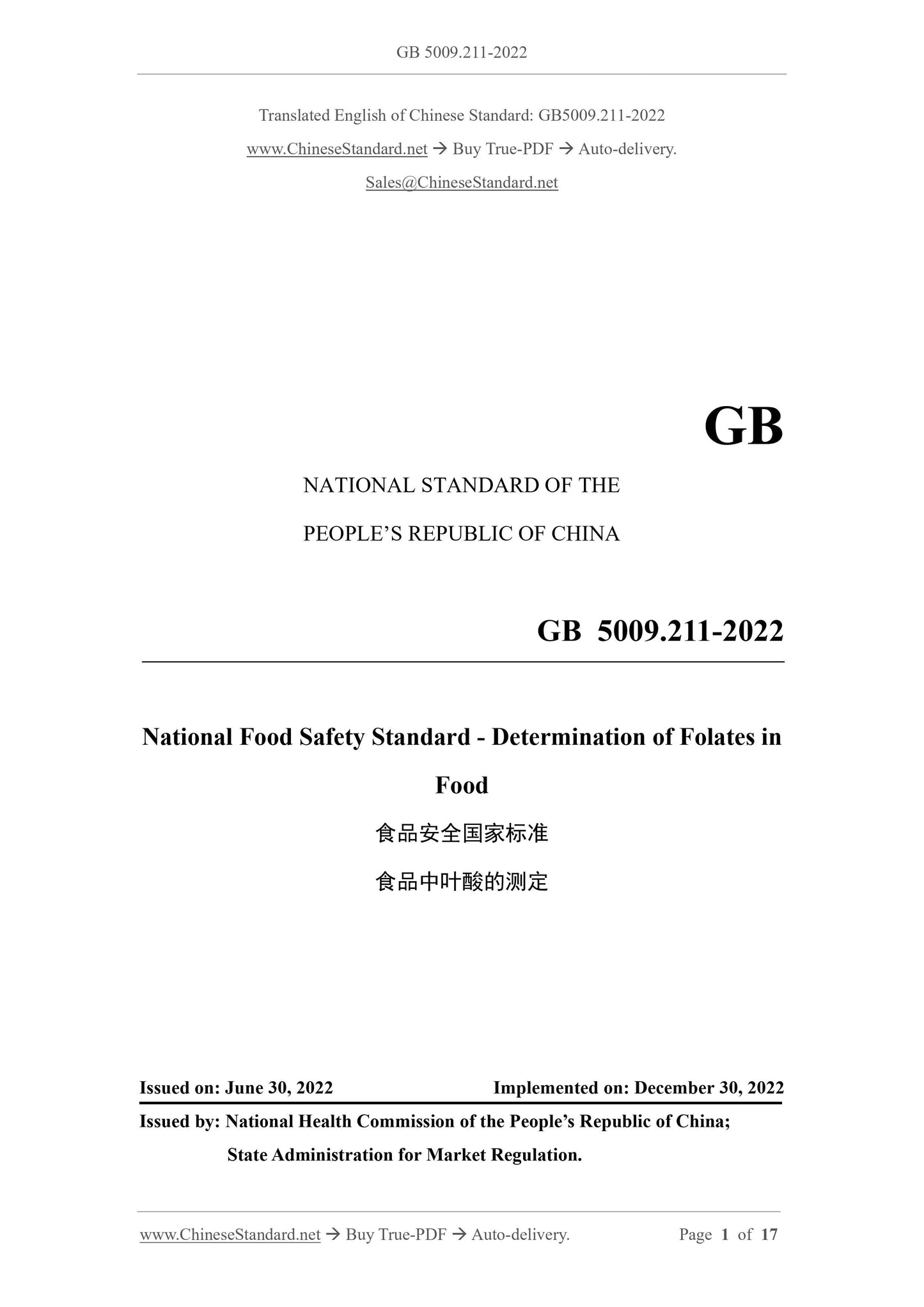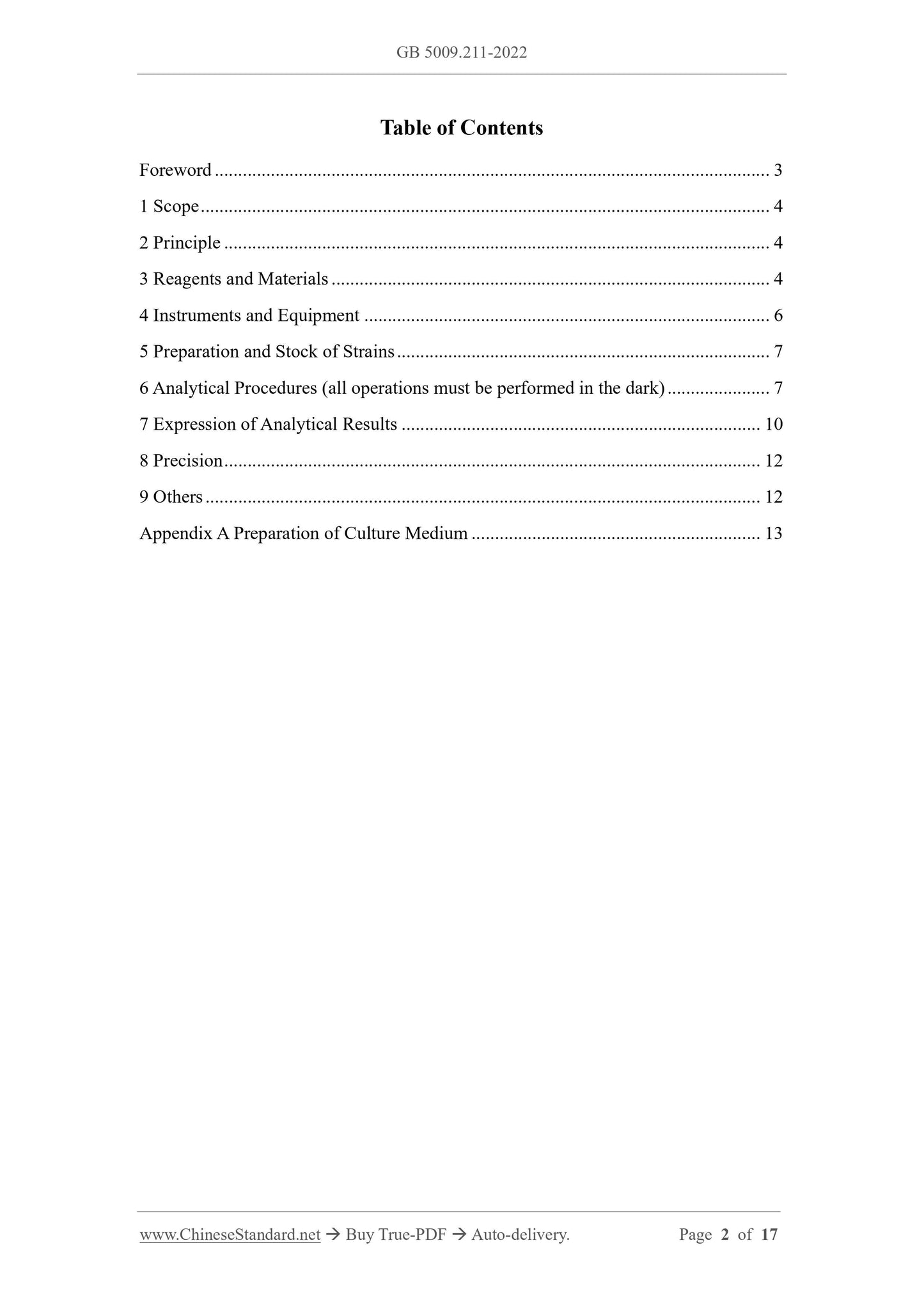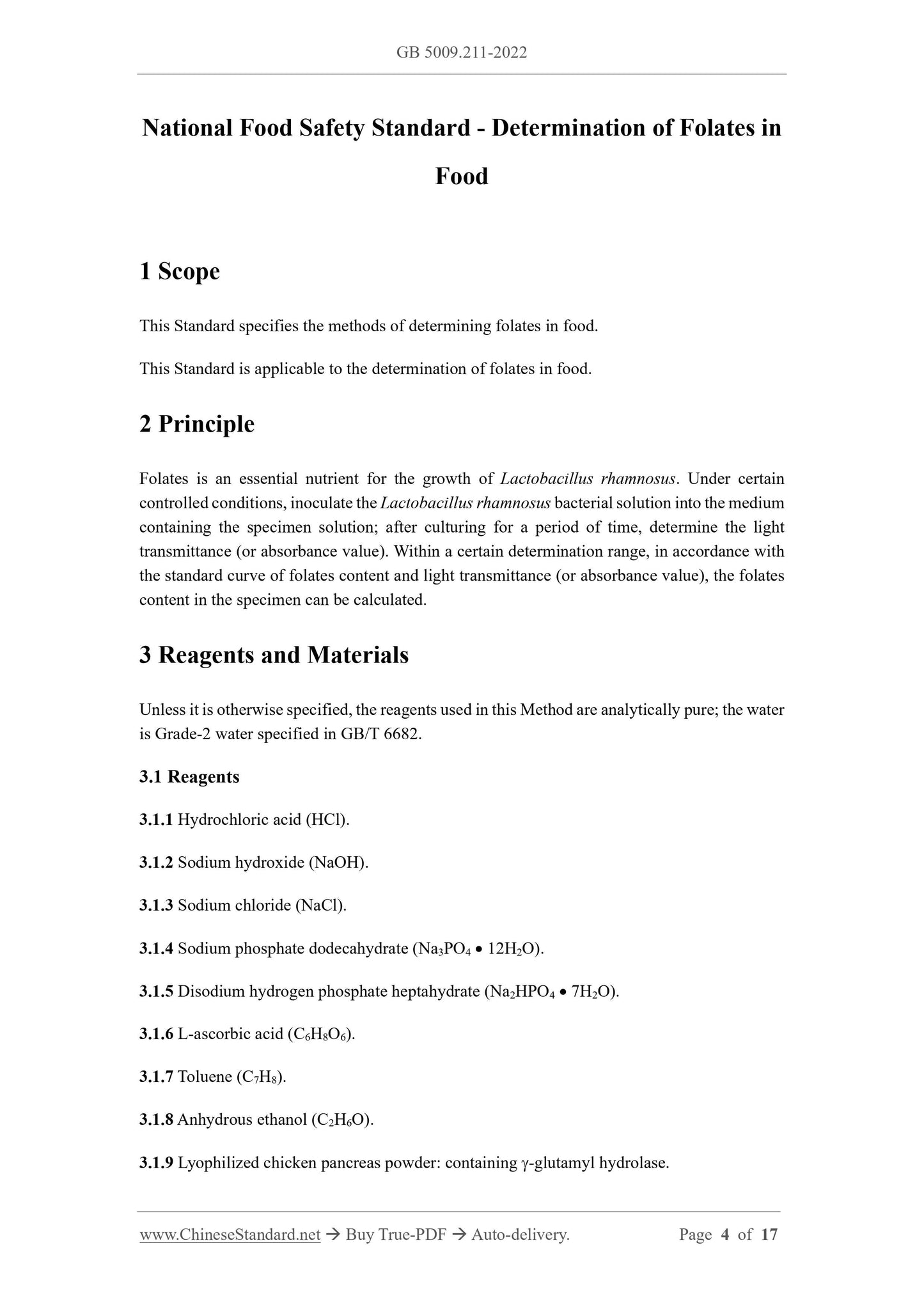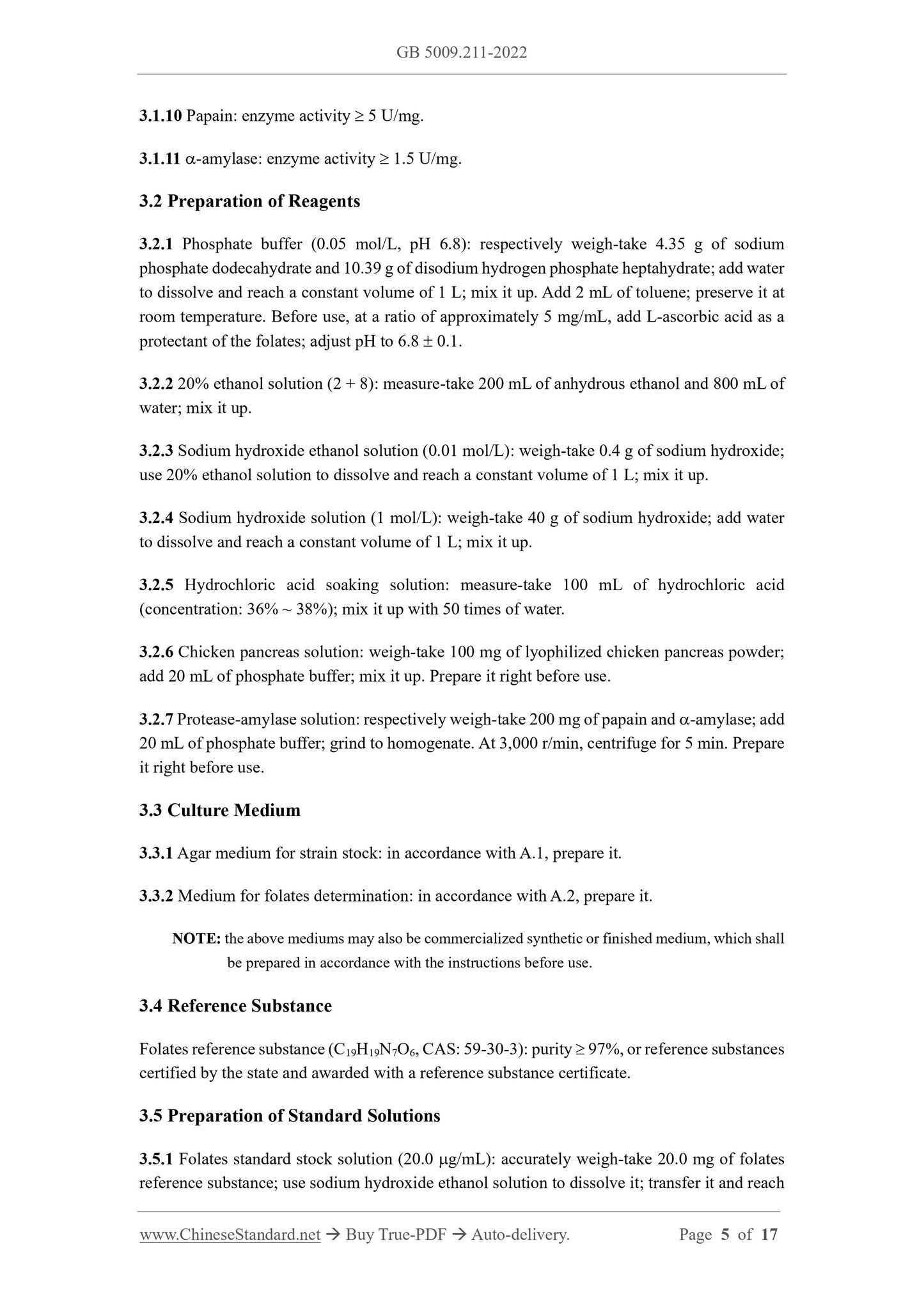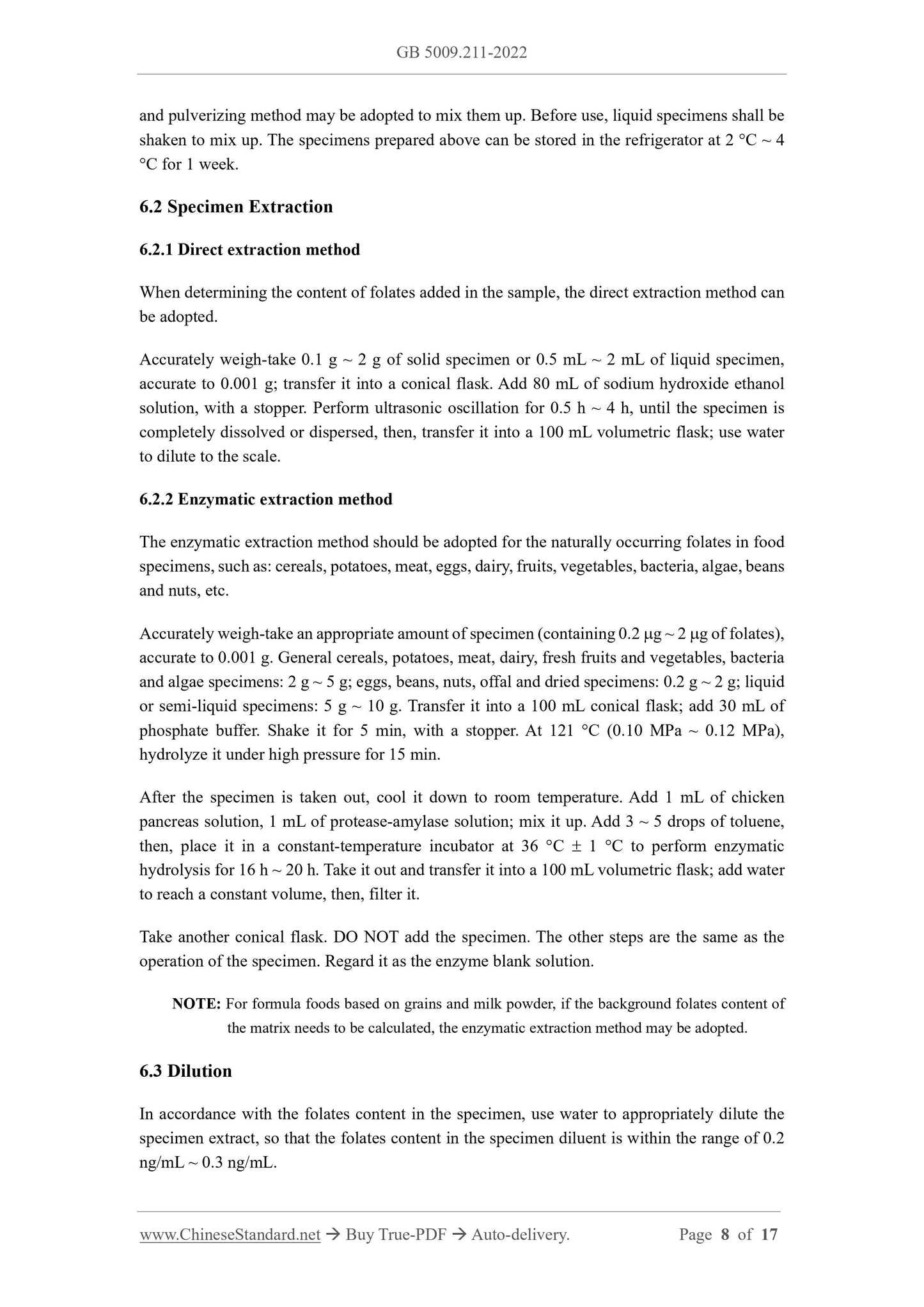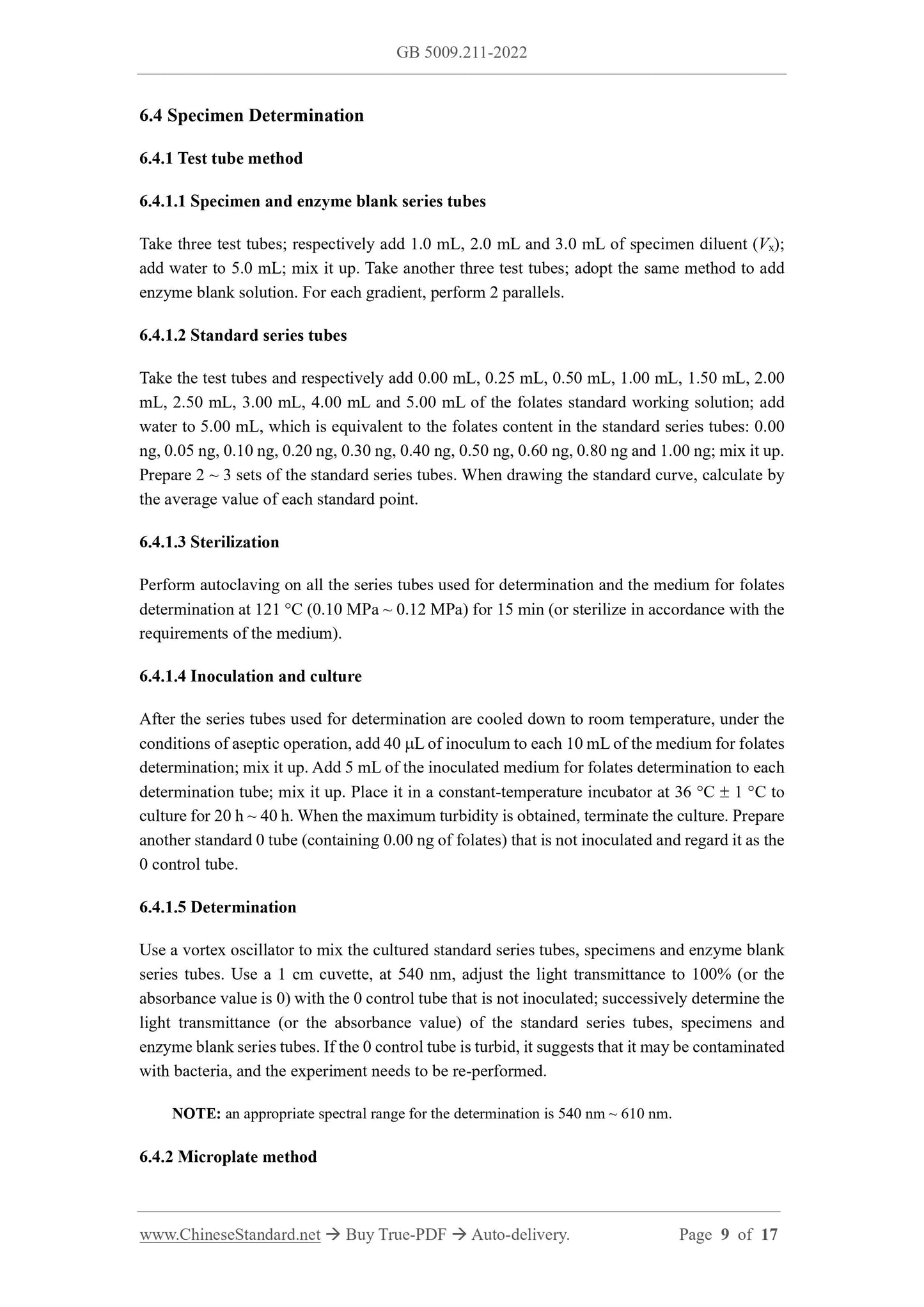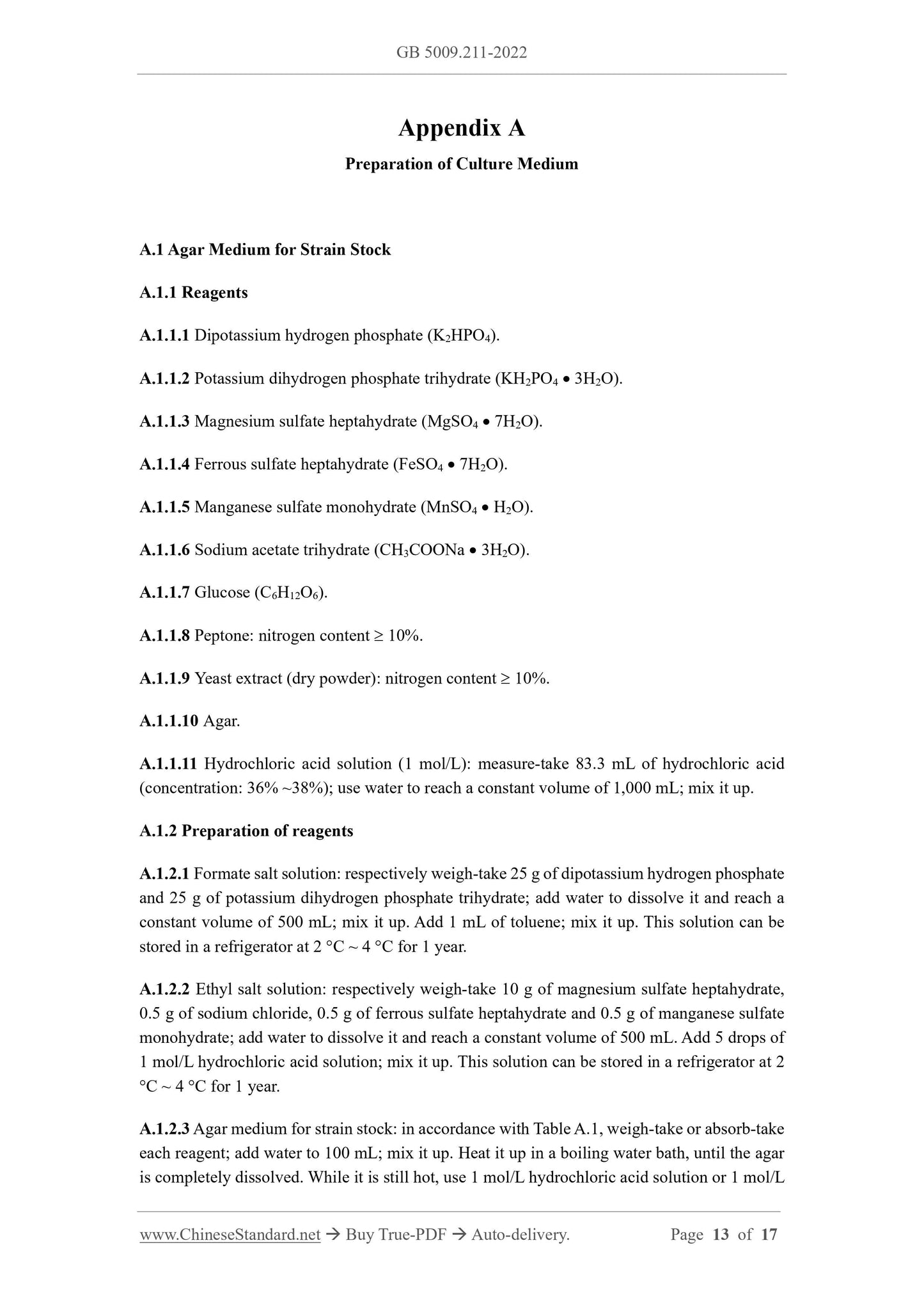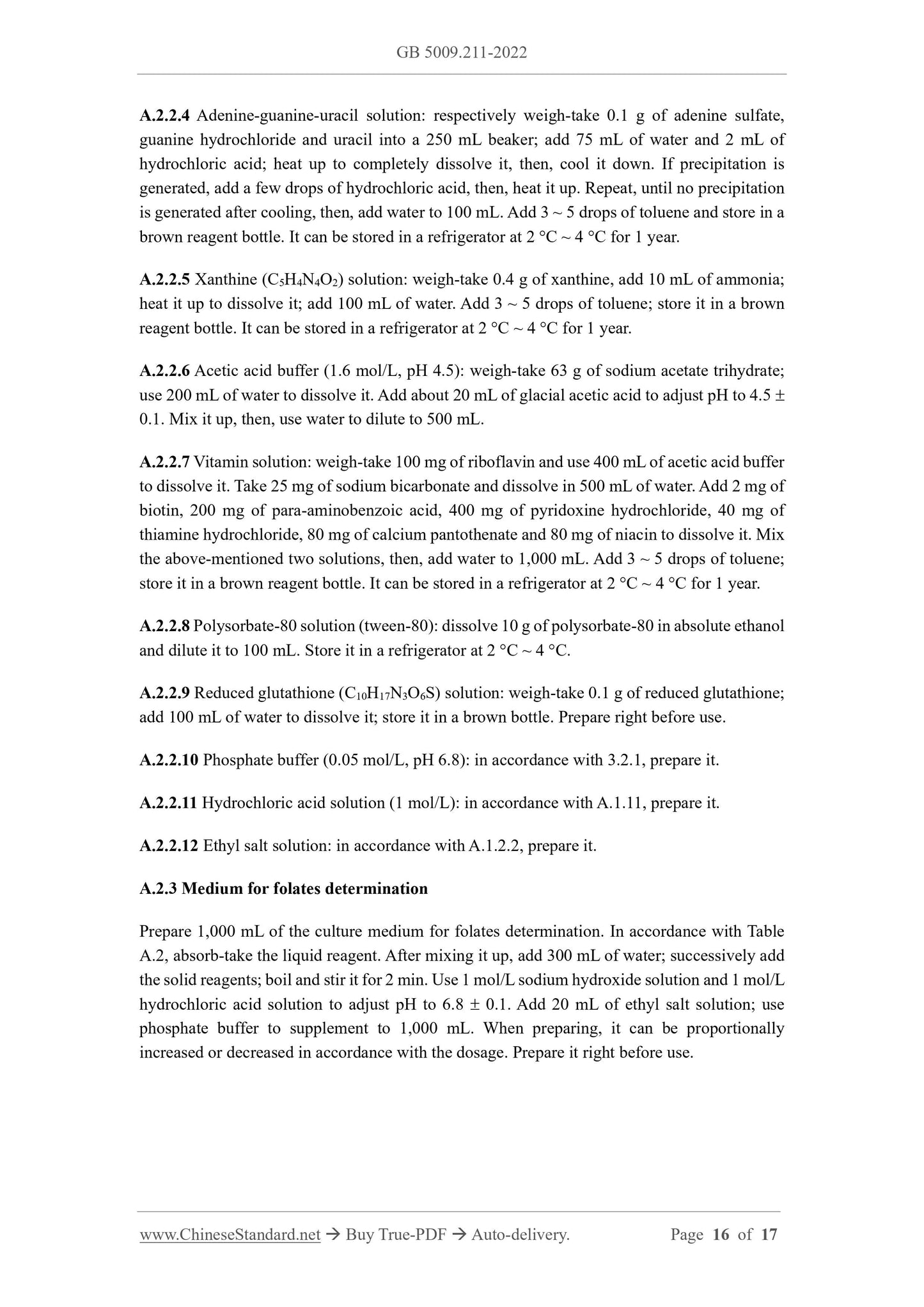PayPal, credit cards. Download editable-PDF & invoice in 1 second!
GB 5009.211-2022 English PDF (GB5009.211-2022)
GB 5009.211-2022 English PDF (GB5009.211-2022)
Precio habitual
$170.00 USD
Precio habitual
Precio de oferta
$170.00 USD
Precio unitario
/
por
Los gastos de envío se calculan en la pantalla de pago.
No se pudo cargar la disponibilidad de retiro
Delivery: 3 seconds. Download true-PDF + Invoice.
Get QUOTATION in 1-minute: Click GB 5009.211-2022
Historical versions: GB 5009.211-2022
Preview True-PDF (Reload/Scroll if blank)
GB 5009.211-2022: National Food Safety Standard - Determination of folates in food
GB 5009.211-2022
NATIONAL STANDARD OF THE
PEOPLE’S REPUBLIC OF CHINA
National Food Safety Standard - Determination of Folates in
Food
ISSUED ON: JUNE 30, 2022
IMPLEMENTED ON: DECEMBER 30, 2022
Issued by: National Health Commission of the People’s Republic of China;
State Administration for Market Regulation.
Table of Contents
Foreword ... 3
1 Scope ... 4
2 Principle ... 4
3 Reagents and Materials ... 4
4 Instruments and Equipment ... 6
5 Preparation and Stock of Strains ... 7
6 Analytical Procedures (all operations must be performed in the dark) ... 7
7 Expression of Analytical Results ... 10
8 Precision ... 12
9 Others ... 12
Appendix A Preparation of Culture Medium ... 13
National Food Safety Standard - Determination of Folates in
Food
1 Scope
This Standard specifies the methods of determining folates in food.
This Standard is applicable to the determination of folates in food.
2 Principle
Folates is an essential nutrient for the growth of Lactobacillus rhamnosus. Under certain
controlled conditions, inoculate the Lactobacillus rhamnosus bacterial solution into the medium
containing the specimen solution; after culturing for a period of time, determine the light
transmittance (or absorbance value). Within a certain determination range, in accordance with
the standard curve of folates content and light transmittance (or absorbance value), the folates
content in the specimen can be calculated.
3 Reagents and Materials
Unless it is otherwise specified, the reagents used in this Method are analytically pure; the water
is Grade-2 water specified in GB/T 6682.
3.1 Reagents
3.1.1 Hydrochloric acid (HCl).
3.1.2 Sodium hydroxide (NaOH).
3.1.3 Sodium chloride (NaCl).
3.1.4 Sodium phosphate dodecahydrate (Na3PO4 12H2O).
3.1.5 Disodium hydrogen phosphate heptahydrate (Na2HPO4 7H2O).
3.1.6 L-ascorbic acid (C6H8O6).
3.1.7 Toluene (C7H8).
3.1.8 Anhydrous ethanol (C2H6O).
3.1.9 Lyophilized chicken pancreas powder: containing -glutamyl hydrolase.
3.1.10 Papain: enzyme activity 5 U/mg.
3.1.11 -amylase: enzyme activity 1.5 U/mg.
3.2 Preparation of Reagents
3.2.1 Phosphate buffer (0.05 mol/L, pH 6.8): respectively weigh-take 4.35 g of sodium
phosphate dodecahydrate and 10.39 g of disodium hydrogen phosphate heptahydrate; add water
to dissolve and reach a constant volume of 1 L; mix it up. Add 2 mL of toluene; preserve it at
room temperature. Before use, at a ratio of approximately 5 mg/mL, add L-ascorbic acid as a
protectant of the folates; adjust pH to 6.8 0.1.
3.2.2 20% ethanol solution (2 + 8): measure-take 200 mL of anhydrous ethanol and 800 mL of
water; mix it up.
3.2.3 Sodium hydroxide ethanol solution (0.01 mol/L): weigh-take 0.4 g of sodium hydroxide;
use 20% ethanol solution to dissolve and reach a constant volume of 1 L; mix it up.
3.2.4 Sodium hydroxide solution (1 mol/L): weigh-take 40 g of sodium hydroxide; add water
to dissolve and reach a constant volume of 1 L; mix it up.
3.2.5 Hydrochloric acid soaking solution: measure-take 100 mL of hydrochloric acid
(concentration: 36% ~ 38%); mix it up with 50 times of water.
3.2.6 Chicken pancreas solution: weigh-take 100 mg of lyophilized chicken pancreas powder;
add 20 mL of phosphate buffer; mix it up. Prepare it right before use.
3.2.7 Protease-amylase solution: respectively weigh-take 200 mg of papain and -amylase; add
20 mL of phosphate buffer; grind to homogenate. At 3,000 r/min, centrifuge for 5 min. Prepare
it right before use.
3.3 Culture Medium
3.3.1 Agar medium for strain stock: in accordance with A.1, prepare it.
3.3.2 Medium for folates determination: in accordance with A.2, prepare it.
NOTE: the above mediums may also be commercialized synthetic or finished medium, which shall
be prepared in accordance with the instructions before use.
3.4 Reference Substance
Folates reference substance (C19H19N7O6, CAS: 59-30-3): purity 97%, or reference substances
certified by the state and awarded with a reference substance certificate.
3.5 Preparation of Standard Solutions
3.5.1 Folates standard stock solution (20.0 g/mL): accurately weigh-take 20.0 mg of folates
reference substance; use sodium hydroxide ethanol solution to dissolve it; transfer it and reach
and pulverizing method may be adopted to mix them up. Before use, liquid specimens shall be
shaken to mix up. The specimens prepared above can be stored in the refrigerator at 2 C ~ 4
C for 1 week.
6.2 Specimen Extraction
6.2.1 Direct extraction method
When determining the content of folates added in the sample, the direct extraction method can
be adopted.
Accurately weigh-take 0.1 g ~ 2 g of solid specimen or 0.5 mL ~ 2 mL of liquid specimen,
accurate to 0.001 g; transfer it into a conical flask. Add 80 mL of sodium hydroxide ethanol
solution, with a stopper. Perform ultrasonic oscillation for 0.5 h ~ 4 h, until the specimen is
completely dissolved or dispersed, then, transfer it into a 100 mL volumetric flask; use water
to dilute to the scale.
6.2.2 Enzymatic extraction method
The enzymatic extraction method should be adopted for the naturally occurring folates in food
specimens, such as: cereals, potatoes, meat, eggs, dairy, fruits, vegetables, bacteria, algae, beans
and nuts, etc.
Accurately weigh-take an appropriate amount of specimen (containing 0.2 g ~ 2 g of folates),
accurate to 0.001 g. General cereals, potatoes, meat, dairy, fresh fruits and vegetables, bacteria
and algae specimens: 2 g ~ 5 g; eggs, beans, nuts, offal and dried specimens: 0.2 g ~ 2 g; liquid
or semi-liquid specimens: 5 g ~ 10 g. Transfer it into a 100 mL conical flask; add 30 mL of
phosphate buffer. Shake it for 5 min, with a stopper. At 121 C (0.10 MPa ~ 0.12 MPa),
hydrolyze it under high pressure for 15 min.
After the specimen is taken out, cool it down to room temperature. Add 1 mL of chicken
pancreas solution, 1 mL of protease-amylase solution; mix it up. Add 3 ~ 5 drops of toluene,
then, place it in a constant-temperature incubator at 36 C 1 C to perform enzymatic
hydrolysis for 16 h ~ 20 h. Take it out and transfer it into a 100 mL volumetric flask; add water
to reach a constant volume, then, filter it.
Take another conical flask. DO NOT add the specimen. The other steps are the same as the
operation of the specimen. Regard it as the enzyme blank solution.
NOTE: For formula foods based on grains and milk powder, if the background folates content of
the matrix needs to be calculated, the enzymatic extraction method may be adopted.
6.3 Dilution
In accordance with the folates content in the specimen, use water to appropriately dilute the
specimen extract, so that the folates content in the specimen diluent is within the range of 0.2
ng/mL ~ 0.3 ng/mL.
6.4 Specimen Determination
6.4.1 Test tube method
6.4.1.1 Specimen and enzyme blank series tubes
Take three test tubes; respectively add 1.0 mL, 2.0 mL and 3.0 mL of specimen diluent (Vx);
add water to 5.0 mL; mix it up. Take another three test tubes; adopt the same method to add
enzyme blank solution. For each gradient, perform 2 parallels.
6.4.1.2 Standard series tubes
Take the test tubes and respectively add 0.00 mL, 0.25 mL, 0.50 mL, 1.00 mL, 1.50 mL, 2.00
mL, 2.50 mL, 3.00 mL, 4.00 mL and 5.00 mL of the folates standard working solution; add
water to 5.00 mL, which is equivalent to the folates content in the standard series tubes: 0.00
ng, 0.05 ng, 0.10 ng, 0.20 ng, 0.30 ng, 0.40 ng, ...
Get QUOTATION in 1-minute: Click GB 5009.211-2022
Historical versions: GB 5009.211-2022
Preview True-PDF (Reload/Scroll if blank)
GB 5009.211-2022: National Food Safety Standard - Determination of folates in food
GB 5009.211-2022
NATIONAL STANDARD OF THE
PEOPLE’S REPUBLIC OF CHINA
National Food Safety Standard - Determination of Folates in
Food
ISSUED ON: JUNE 30, 2022
IMPLEMENTED ON: DECEMBER 30, 2022
Issued by: National Health Commission of the People’s Republic of China;
State Administration for Market Regulation.
Table of Contents
Foreword ... 3
1 Scope ... 4
2 Principle ... 4
3 Reagents and Materials ... 4
4 Instruments and Equipment ... 6
5 Preparation and Stock of Strains ... 7
6 Analytical Procedures (all operations must be performed in the dark) ... 7
7 Expression of Analytical Results ... 10
8 Precision ... 12
9 Others ... 12
Appendix A Preparation of Culture Medium ... 13
National Food Safety Standard - Determination of Folates in
Food
1 Scope
This Standard specifies the methods of determining folates in food.
This Standard is applicable to the determination of folates in food.
2 Principle
Folates is an essential nutrient for the growth of Lactobacillus rhamnosus. Under certain
controlled conditions, inoculate the Lactobacillus rhamnosus bacterial solution into the medium
containing the specimen solution; after culturing for a period of time, determine the light
transmittance (or absorbance value). Within a certain determination range, in accordance with
the standard curve of folates content and light transmittance (or absorbance value), the folates
content in the specimen can be calculated.
3 Reagents and Materials
Unless it is otherwise specified, the reagents used in this Method are analytically pure; the water
is Grade-2 water specified in GB/T 6682.
3.1 Reagents
3.1.1 Hydrochloric acid (HCl).
3.1.2 Sodium hydroxide (NaOH).
3.1.3 Sodium chloride (NaCl).
3.1.4 Sodium phosphate dodecahydrate (Na3PO4 12H2O).
3.1.5 Disodium hydrogen phosphate heptahydrate (Na2HPO4 7H2O).
3.1.6 L-ascorbic acid (C6H8O6).
3.1.7 Toluene (C7H8).
3.1.8 Anhydrous ethanol (C2H6O).
3.1.9 Lyophilized chicken pancreas powder: containing -glutamyl hydrolase.
3.1.10 Papain: enzyme activity 5 U/mg.
3.1.11 -amylase: enzyme activity 1.5 U/mg.
3.2 Preparation of Reagents
3.2.1 Phosphate buffer (0.05 mol/L, pH 6.8): respectively weigh-take 4.35 g of sodium
phosphate dodecahydrate and 10.39 g of disodium hydrogen phosphate heptahydrate; add water
to dissolve and reach a constant volume of 1 L; mix it up. Add 2 mL of toluene; preserve it at
room temperature. Before use, at a ratio of approximately 5 mg/mL, add L-ascorbic acid as a
protectant of the folates; adjust pH to 6.8 0.1.
3.2.2 20% ethanol solution (2 + 8): measure-take 200 mL of anhydrous ethanol and 800 mL of
water; mix it up.
3.2.3 Sodium hydroxide ethanol solution (0.01 mol/L): weigh-take 0.4 g of sodium hydroxide;
use 20% ethanol solution to dissolve and reach a constant volume of 1 L; mix it up.
3.2.4 Sodium hydroxide solution (1 mol/L): weigh-take 40 g of sodium hydroxide; add water
to dissolve and reach a constant volume of 1 L; mix it up.
3.2.5 Hydrochloric acid soaking solution: measure-take 100 mL of hydrochloric acid
(concentration: 36% ~ 38%); mix it up with 50 times of water.
3.2.6 Chicken pancreas solution: weigh-take 100 mg of lyophilized chicken pancreas powder;
add 20 mL of phosphate buffer; mix it up. Prepare it right before use.
3.2.7 Protease-amylase solution: respectively weigh-take 200 mg of papain and -amylase; add
20 mL of phosphate buffer; grind to homogenate. At 3,000 r/min, centrifuge for 5 min. Prepare
it right before use.
3.3 Culture Medium
3.3.1 Agar medium for strain stock: in accordance with A.1, prepare it.
3.3.2 Medium for folates determination: in accordance with A.2, prepare it.
NOTE: the above mediums may also be commercialized synthetic or finished medium, which shall
be prepared in accordance with the instructions before use.
3.4 Reference Substance
Folates reference substance (C19H19N7O6, CAS: 59-30-3): purity 97%, or reference substances
certified by the state and awarded with a reference substance certificate.
3.5 Preparation of Standard Solutions
3.5.1 Folates standard stock solution (20.0 g/mL): accurately weigh-take 20.0 mg of folates
reference substance; use sodium hydroxide ethanol solution to dissolve it; transfer it and reach
and pulverizing method may be adopted to mix them up. Before use, liquid specimens shall be
shaken to mix up. The specimens prepared above can be stored in the refrigerator at 2 C ~ 4
C for 1 week.
6.2 Specimen Extraction
6.2.1 Direct extraction method
When determining the content of folates added in the sample, the direct extraction method can
be adopted.
Accurately weigh-take 0.1 g ~ 2 g of solid specimen or 0.5 mL ~ 2 mL of liquid specimen,
accurate to 0.001 g; transfer it into a conical flask. Add 80 mL of sodium hydroxide ethanol
solution, with a stopper. Perform ultrasonic oscillation for 0.5 h ~ 4 h, until the specimen is
completely dissolved or dispersed, then, transfer it into a 100 mL volumetric flask; use water
to dilute to the scale.
6.2.2 Enzymatic extraction method
The enzymatic extraction method should be adopted for the naturally occurring folates in food
specimens, such as: cereals, potatoes, meat, eggs, dairy, fruits, vegetables, bacteria, algae, beans
and nuts, etc.
Accurately weigh-take an appropriate amount of specimen (containing 0.2 g ~ 2 g of folates),
accurate to 0.001 g. General cereals, potatoes, meat, dairy, fresh fruits and vegetables, bacteria
and algae specimens: 2 g ~ 5 g; eggs, beans, nuts, offal and dried specimens: 0.2 g ~ 2 g; liquid
or semi-liquid specimens: 5 g ~ 10 g. Transfer it into a 100 mL conical flask; add 30 mL of
phosphate buffer. Shake it for 5 min, with a stopper. At 121 C (0.10 MPa ~ 0.12 MPa),
hydrolyze it under high pressure for 15 min.
After the specimen is taken out, cool it down to room temperature. Add 1 mL of chicken
pancreas solution, 1 mL of protease-amylase solution; mix it up. Add 3 ~ 5 drops of toluene,
then, place it in a constant-temperature incubator at 36 C 1 C to perform enzymatic
hydrolysis for 16 h ~ 20 h. Take it out and transfer it into a 100 mL volumetric flask; add water
to reach a constant volume, then, filter it.
Take another conical flask. DO NOT add the specimen. The other steps are the same as the
operation of the specimen. Regard it as the enzyme blank solution.
NOTE: For formula foods based on grains and milk powder, if the background folates content of
the matrix needs to be calculated, the enzymatic extraction method may be adopted.
6.3 Dilution
In accordance with the folates content in the specimen, use water to appropriately dilute the
specimen extract, so that the folates content in the specimen diluent is within the range of 0.2
ng/mL ~ 0.3 ng/mL.
6.4 Specimen Determination
6.4.1 Test tube method
6.4.1.1 Specimen and enzyme blank series tubes
Take three test tubes; respectively add 1.0 mL, 2.0 mL and 3.0 mL of specimen diluent (Vx);
add water to 5.0 mL; mix it up. Take another three test tubes; adopt the same method to add
enzyme blank solution. For each gradient, perform 2 parallels.
6.4.1.2 Standard series tubes
Take the test tubes and respectively add 0.00 mL, 0.25 mL, 0.50 mL, 1.00 mL, 1.50 mL, 2.00
mL, 2.50 mL, 3.00 mL, 4.00 mL and 5.00 mL of the folates standard working solution; add
water to 5.00 mL, which is equivalent to the folates content in the standard series tubes: 0.00
ng, 0.05 ng, 0.10 ng, 0.20 ng, 0.30 ng, 0.40 ng, ...
Share
